Coniferous evergreen plant, cypress, grown not only in the open soil, but at home. Room cypress - a miniature copy of his tall "relatives", has a decorative attractive form of the crown and a pleasant, healing aroma.
How does cypress grow at home? What conditions need to create perennials in a flower pot? How to care for cypress so that the plant pleases the surrounding many years? Features of the cultivation of cypress on the windowsill - in this selection of material.
Plant Kiparis: Features of the genus interesting facts
- Evergreen shrub or tree, extensive genus of cypress, refers to the family of cypress.
- The coniferous plant with a sprawler or a pyramid crown has an ancient history of origin and has more than 20 species.
- What does cypress look like in a natural habitat? Famous with ancient times, evergreen cypresses in nature have the form of high and mighty trees-giants. The height of them reaches 30 meters, the diameter of the trunk is up to 60 cm.
- The historical homeland of cypresses is considered the Mediterranean, therefore the most favorable climate for many years of culture are tropics or subtropics.
- Small leaflets of cypress are modified over time: the young leaves have the kind of needles, adults look in the form of scales that have grown to branches, running on each other in a tiled order. The needles are painted in dark green.
- Egg-shaped cones of evergreen cypress ripen by the 2nd year of life. When calculating the scales, the seeds-shaped cypress seeds are released.
- The cypress tree advantageously grows in the warm, southern regions, has drought-resistant qualities and makes non-losant frosts, but not higher than -20 0WITH.
- The trees of wild evergreen cypresses - record holders for long-life. Under favorable conditions, they can grow up to 2000 years.
- Valuable high-strength wood of centuries-old cypress has long been used to build vessels and in the manufacture of furniture.
- In addition to practical use, the plant used the special "cult" attention of many religions. The ancient Romans considered a tree a symbol of sadness and planted it in cemeteries or near tomb. In Christians, on the contrary, cypress was recognized as one of the representatives of the Paradise Garden and was an omname of eternal life. Some biblical data indicate that it was from this tree a saving ark. And the ancient Greek epic tells about a beautiful legend, when the young man named Kiparis killed the Horse of God Apollo, for which he was for life for life in an evergreen tree.
What is the difference between cypress and cypressics?
Many lovers of evergreen plants often confuse their representatives, in particular: cypress and cypress. Indeed, trees are very similar not only to the name, but also appearance.
- To avoid such confusion, it should be noted that these are two different kind of coniferous crops from the general family of cypress.
- In nature, the cypressik is the same high plant, but with more flat branches and small bumps with two seeds. In the cones of cypress seeds are formed much more.
- A distinctive feature of the cypressive are the leaves: they are smaller and lighter by color than the kind of cypress.
- The cypressovik differs from cypress greater degree of frost resistance, but less durability.
- Some varieties of cypresses are as well as cypress, successfully cultivated as a room culture.
- Care for two "relatives" is very similar, so when cultivated cultures, such a confusion will not have much importance.
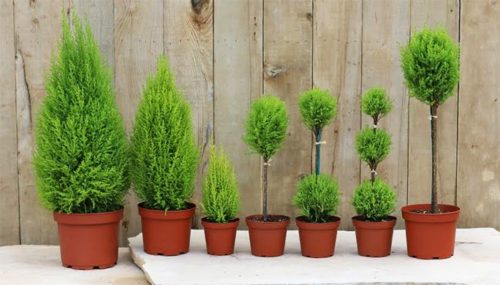
Cypress home, description of the plant
- The bred varieties of cypress, grown at home (as indoor plants), are usually as a rule, a large-scale type of cypress and differ in small compact forms.
- In nature, a large-scale cypress - a high evergreen tree with a cheese, resembling the smell of lemon. A colonum crown of a young plant with age is growing and converted into an empty shape.
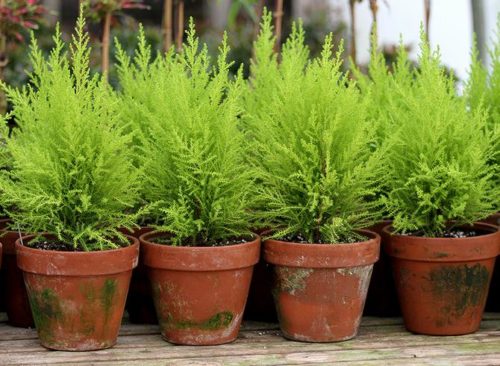
- The birthplace of this thermo-loving species of cypress - Southern California. Therefore, the plant is grown purely as a houseplant that is not able to winter in a cold climate.
- Cypress is a lightweight culture, preferring moderate ambient temperature and high air humidity. In opposite conditions (high temperature and low humidity), the tree resets the needles, and the branches dry out, without the possibility of regeneration. Naturally, with such conditions unfavorable for cypress, the plant loses its attractiveness and can even die.
- Home Ciparis is different from natural "relative" significantly smaller dimensions and a neat, compact crown.
- The form of cypress, grown at home in a pot, grows slowly and reaches in a mature age height of no more than 2 meters. As a rule, it is highly decorative miniature trees with a clear pyramidal crown.
- Room cypress not only decorates the dwelling, but is very useful for the human body by a plant. The needles highlights biologically active substances - phytoncides and has a light pleasant lemon aroma.
Where to buy and how to choose indoor cypress?
For the cultivation of cypress at home, it is possible to use both ordinary varieties of plants and bred, dwarf shapes.
In the first case, it will have to be patient and trigger the perennial roots every year, artificially restraining his further growth.
The second option of acquiring a miniature variety of cultural cypress will be the most successful and convenient.
You can purchase a variety of room cypress in the nursery, botanical garden or a specialized store. As a rule, it presents a variety of large-scale species of cypress. It is necessary to purchase an externally healthy and green (without dry needles) a seedling with a closed root system. When buying should also be clarified whether the grade is intended for growing at home. The coniferous plant, excessing useful phytoncides, will be appropriate in any interior of the house.
What kind of grade is best suited for growing coniferous perennial in pots, consider below.
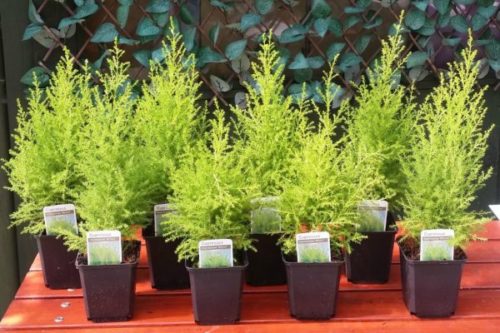
Varieties of room cypress
At home, according to the principle of "bonsai", it is possible to grow not only cypress a large-scale, but also other types of coniferous perennials, such as: cypress elegant, cypress evergreen, cypress thread or weeping.
For home cultivation, the bred room varieties of cypress are best suited:
- Kiparis Goldcrest Wilma.
Popular room of coniferous cypress, characterized by an unusual, salad-yellow color of needles. A variety, often called "golden", was removed by breeders from the UK. Decorative cypress has a reprehensive trunk and a pyramidal form of the crown. In adulthood, the pot plant reaches no more than 2 meters in height.
- Kiparis Elevood.
A slowly growing form of cypress, with an annual crown growth of about 3-5 cm, by 10 years reaches one and a half meters in height. Crown of proper, cone-shaped, shoots flexible and short. Needle young leaves with age becomes scaly. The jam-green tint of foliage by winter acquires a bluish color. The plant is unpretentious in care. Cypress Elvudi Gold's variety is distinguished by a golden tip of green shoots. Grade Elvudi White is highlighted by a whitish tint, in general, green needles.
- Kiparis "Nana Grazilis".
The lowest, slowly growing shrub - dwarf, reaching in an adult, no more than 60 cm. Croon spread, bicycle irregular shape. Green needles, glossy; The branching of escapes is dense and swirling. Variety is light-headed and hardy.
- Kiparis Snow White.
A decorative dwarf shrub, reaching a height of about a meter, in the diameter of the crown no more than 50-60 cm. Annual shooting of shoots is 5-6 cm. Thickened, highly branching cypress branches form a dense symmetric crown of oval shape. Coffee color - greenish blue with silver tint.

Landing home cypress: features of agrotechnics
- When boarding a room coniferous plant, the most important thing is to choose the proper soil for cypress.
- It should be an easy, loose and nutrient soil, which can be made independently or purchase ready-made in the garden shop. When buying land for cypress, you should choose a soil intended for coniferous plants.
- To independently make the necessary mixture, mix large river sand, peat, turf and leafy land in the ratio of 1: 1: 1: 2.
- The pot for cypress should be 3-4 cm more root plant plant and be sure to have holes for the flow of excess water. The best option is a clay pot, whereas in the plastic container the soil will dry faster, and in winter it is faster than cooling.
- When landing 1 \\ 4, part of the flower pot occupies a drainage layer of fine pebbles or clay.
- Directly on the drainage, the prepared soil is poured, a seedlock is set and falling asleep (without the reeling of the root cervix) the remaining part of the soil. When landing, the soil is slightly tamped so that air emptiness is not formed.
- After planting a cypress flower watered with water.
- The period of suitability of cypress is somewhat painful, so the pot with a flower at first put in the shade and reduce the watering, thus providing a more sparing mode.
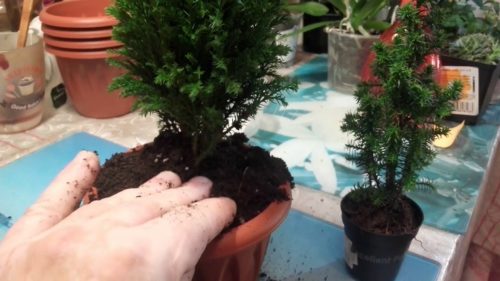
Features of growing decorative home cypress
Homemade cypress will be happy to delight with its attractive decorativeness and pleasant coniferous aroma while complying with key rules for evergreen culture.
How to grow cypress at home? The secret is simple - it is necessary to recreate the conditions close to the natural habitat of the coniferous plant.
Cypress location and lighting at home
- The light-headed "Yazhann" - cypress needs a sufficient number of light, so the pot must be put in a well-lit place. It can be a windowsill, flower stand or floor.
- At the same time, it is necessary to avoid direct ingress of sunlight on the perennial chevy. The optimal option is scattered sunlight with shading in hot summer half days.
- As a rule, a pot with cypress in the winter is put up in the south side of the house, while in the summer - in the northern part.
- In winter, with a lack of natural light, artificial lamps are used to highlight cypress.
- The lack of light causes the drawing of the branches of the cypress, thereby disrupting the decorative type of crown.
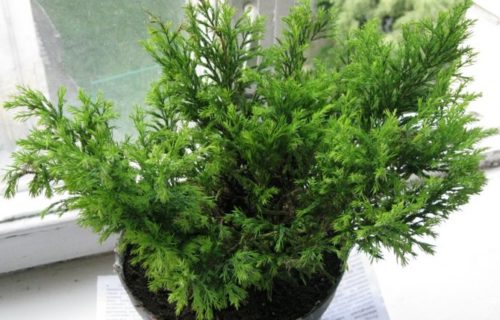
Temperature regime for cypress at home
- The subtropical "past" of the thermo-loving cypress predetermines its requirements for the temperature regime in the room where it grows.
- This should be a room with a moderate temperature regime.
- In the care of evergreen cypress, it is necessary to observe natural seasonality, providing him in the summer, warm conditions, and in winter - cool.
- In the summer, the plant perfectly suitable room temperature in the room (not on the sunny side).
- One of the key factors of successful cultivation of cypress in the apartment is fresh air access. The perennial does not tolerate tears or stagnation. Therefore, in the warm season, the pot with a flower is better to take a balcony or to the courtyard (in the shadow). If there is no such possibility - it is important to regularly air the room.
- In winter, cypress should not be near the heating devices. At this time of the year, the plant will be enough 8-10 0From heat (not higher +15 0WITH). You can put a pot with a flower on a glazed balcony, insulates the vase with foam or rag.

Rules of watering for cypress home
- Cypress is beneficial to high humidity and regular watering.
- For home, the cypress is undesirable both excessive watering, with moisture stagnation and soil drying.
- The principle of watering can be denoted by a non-loud algorithm: the hotter - the more often watering than the cooler - the less irrigation.
- Watering rates should ensure constantly moistened soil, without cutting and forming crusts. In the event that the Earth still dryed and crackled, the pot needs to be lowered into a container with water for a while.
- Kiparis "loves" a spraying of the crown. The procedure is better to spend 2 times a day: in the morning and evening. Spray indoor plant only in the hot season.
- For watering and sprinkling, it is necessary to use the dilated water of room temperature.
- In order to increase the humidity of the air, you can put a tank with water or a flower pot itself or the flower pot of the clamisite in the pallet itself. The evaporation of moisture will significantly increase the humidity in the room.
- In winter, the irrigation rate is reduced, while the soil still should not disappear.

Putting fertilizers and subcortex of room cypress
- Exotic cypress needs periodic feeding, but ordinary fertilizers for potted cultures will not suit him.
- It is best to purchase mineral fertilizers for coniferous plants. The composition should include magnesium and nitrogen, but the last element is not in high dosages.
- Movements make a monthly, starting from May and ending with August.
- Experienced flowers are recommended to independently reduce the fertilizer concentration recommended on the package.
- It is impossible to use humid or manure to fertilize cypress, since such aggressive organic feeding can permanently destroy the perennial.
Cypress home trimming
- An early spring is performed by a sanitary or forming crown of the cypress crown.
- Sanitary trim involves removing dry, old and damaged sprigs of room cypress.
- Optionally, you can resort to the forming trimming, giving a perennially desired crown form. To save the specified crown form, you will have to regularly trim the growing shoots. This type of trimming is not necessarily optional, since cypress from nature has a rather attractive form of a crown forming naturally.
- Rule of painless trimming - removal of not more than 1 \\ 3 parts of the shoots. The procedure for properly conducted trimming not only reflects the appearance of coniferous culture, but also stimulates the further development of the cypress crown.
- Additional, albeit temporary, receiving, braking the growth of home cypress, is the pinching of the top point of the growth of the main escape of many years of culture.
- If the cypress has grown too high for room content, you can cut off its top, and the side shoots "Correct", according to the crown form. In this case, the cut-off top rooted in a separate vase.
Cypress-room transplant at home
Periodically, cypress needs a transplant. The reasons may be somewhat: soil in a pot in 2-3 years loses most of the beneficial substances and needs to be updated, or the flower pot has become small and you need a random Vase.
How to transplant the cypress?
- The convection of the coniferous plants is usually planned for spring.
- Before replanting, cypress is abundantly shedding with water so that it is easy to remove the plant.
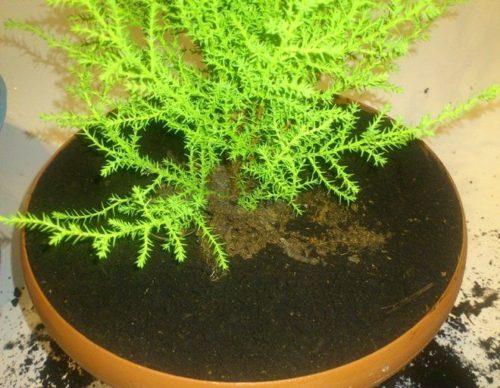
- Given the sensitive roots of cypress, it is necessary to transplant it very carefully, the way "transshipment". This means the replacement of only soil that is easily devastated from the roots of perennials, without "excessive perseverance" and injury to gentle roots.
- After an abundant watering, the cypress is removed from the pot together with a room of land, which is easily separated with a weak shock.
- After the release of the roots, it is worth considering the plant carefully. In the case of germination of a young process, it is separated from the trunk for further reproduction, and the location of the cut is lubricated with garden water. The process is separated from cypress with a part of the root system.
- After the manipulation done, the cypress land in the pot according to the rules described above (in the section "Planting Kiparis").
- The process is planted into a separate small container and the first time "hold" under a glass jar for successful rooting.
Diseases and pests of cypress home
Cypress decorative is resistant to many diseases and pests. The coniferous aroma of evergreen culture scares insects, and the chemical composition of wood (in particular, fungicides) "opposes" by most fungal or bacterial diseases.
- Occasionally, cypress can annoy the shields (or spoors) that feed on the juice of the foliage of many years of culture. Get rid of the pest will help wiping with soap or alcoholic solution.
- With a dry air in the room where the plant is located, a web can appear on the needle, testifying to the settlement on the green shoots of the pawkin tick.
- In case of yellowing of individual fragments of the plant, it is possible to infect a tool. Extermination of unwanted insects will help watering with water, followed by spraying with soap solution (with the addition of a small amount of vegetable oil).
- To combat insect pests, a cypress spraying solution of a wide range of a wide range of action, for example, accutelica is used. As prevention, re-processing is carried out again, in a week. Crane processing is better spent on the street.
- Diseases of home cypress are associated with violation of the rules of culture of culture: excessive overvailing causes root rotting; Low humidity leads to the fact that the cypress dries.
- The struggle against the root rot will require a plant transplant to a new soil (with a high drainage layer), with the obligatory removal of all rotten sites. After the "resuscitation" of the plant should not overdo it with watering evergreen culture.

The reproduction of room cypress
Room cypress can be multiplied with cuttings and seeds. The hauling is considered the simplest and most common way to breed a coniferous culture.
Seed method of breeding cypress home
- This method of reproduction is considered a rather long and time-consuming process.
- Seeds can be purchased in the store or assemble from the discontinued green cones of coniferous perennial.
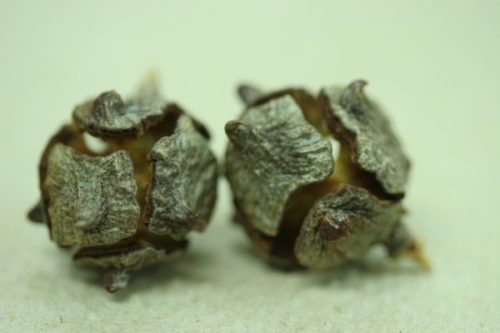
- The preparation of seeds of Ciparis implies compulsory stratification (hardening) when the seeds are kept in the refrigerator at least 3 months before landing.
- Seeds for sowing is better to use fresh, not settled. Seed seeds in spring. The germination of cypress seeds is low - about 30% of the total.
- Before sowing, seeds are soaked in warm water overnight. You can also use plant growth biostimulants: Korniner, Epin.
- Seeds are sowing into a specially prepared container with moistened soil (for coniferous crops), on the bottom of which 2-centimeter drainage from fine chips of the cortex are placed. An alternative to the soil may become sand or sawdust, but the shootings that appeared still need to be transplanted into the ground.
- The container with seeds put for 2-3 weeks in a slightly shaded warm place. You can pull the film to the container, providing a greenhouse effect.
- When the first shoots appear, the container is rearranged to a sunny place.
- Seeding care includes moderate watering, ventilating (in case of covering with a film) and heat.
- About a month later (when the height of germs will be about 5 cm) seedlings are transplanted by individual containers.
- When transplanting seedlings, the neck of the plant does not plunge into the ground. For the year of the kiparis bush reaches about 20 cm.
The reproduction of cypress with cuttings at home
- Shining cypress is carried out early in spring or early autumn.
- For cuttings, the top or semi-restless side shoots are used, about 10 cm long.
- Sliced \u200b\u200bshoots remove the lower leaves and leave the cuttings for a day in the corneser solution.
- After that, the sections are lubricated with crowded coal and plant in containers with prepared soil. The cuttings are plugged into the ground at 1 \\ 3 of their heights.
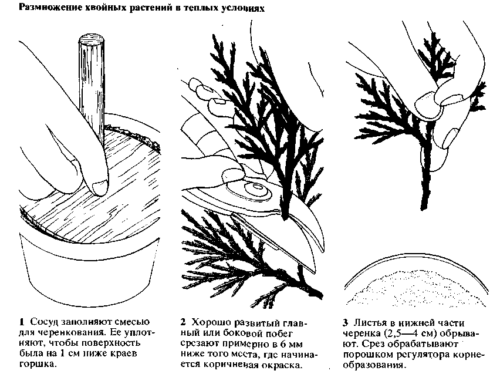
- The ground in the container is moisturized, and each cutlets are covered with a glass jar, creating the effect of mini-greenhouse.
- Care behind cuttings lies in regular watering and periodic ventilation, removing the cans 3-4 times a week.
- It will take about 2 months to rooug the cuttings.
Practical Purchase Tips for Room Cypress
- A great role of successful cultivation of cypress in a flower pot plays correctly selected soil. Do not save on a soil for coniferous culture. The incorrectly selected soil subsequently leads to a delay in the growth and development of the flower, changing the painting of the needles: it becomes a faded, with an inesttic raid.
- An important factor in the full development of cypress will be good, but scattered lighting. Straight solar rays (or high indoor temperature) provoke the drying of individual parts of the cypress. In this case, damaged areas are subject to removal, and the plant will require a new, more "safe" location.
- To understand how much and how often to water the room plant - it is necessary to pay attention to the state of the Earth in the pot. It should always be slightly moistened (without stagnation of water and driving).
- Regular spraying will provide a juicy healthy hive cypress.
- The skillful trimming of the shoots of cypress allows the crown to give a diverse, attractive form.
- If the edges of the cypress foliage begins to turn yellow and squeeze, the reasons may be somewhat: the peashed air, insufficient watering or lighting, low air temperature, lack of nutritional elements in the ground. If the shoots of cypress will dry only with one, concrete, the parties are likely to have any source of artificial heat (battery, heater).
- Caring for indoor cypress in winter has a number of features: low temperature regime, reduction of irrigation rates, cancellation of sprinkle.
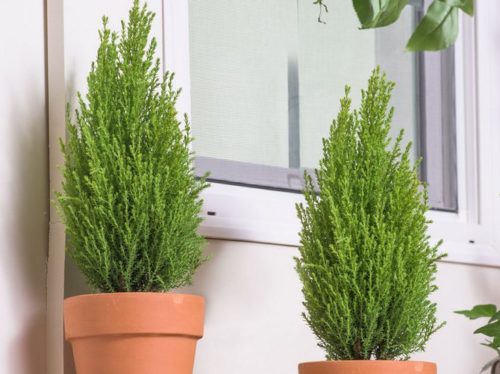
So, a unique and beautiful plant, cypress, can be easily grown as a room culture. A majestic noble conifer plant will become a real decoration of any room, a decorative element of a veranda or a porch. Attractive appearance and pleasant lemon fragrance, along with unpretentiousness and endurance, made cypress favorite in many connoisseurs of home plants.

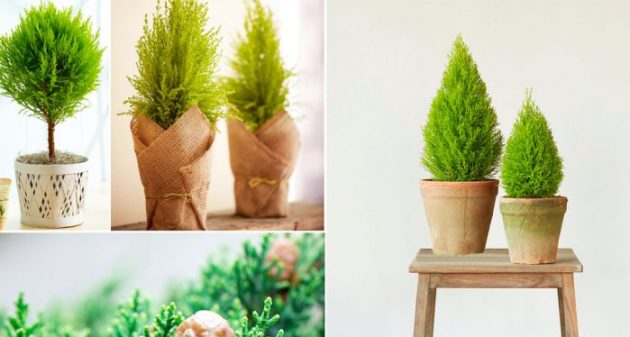
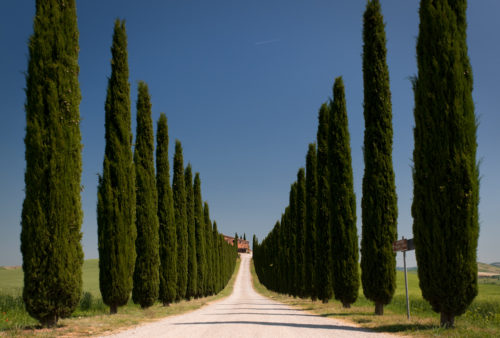


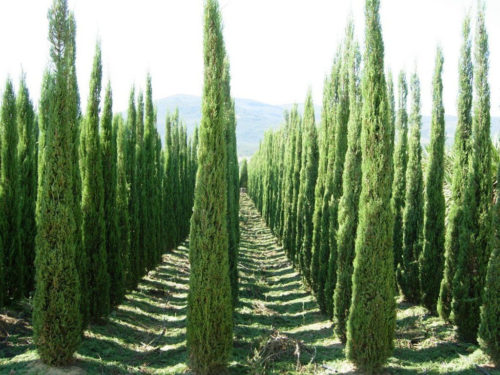
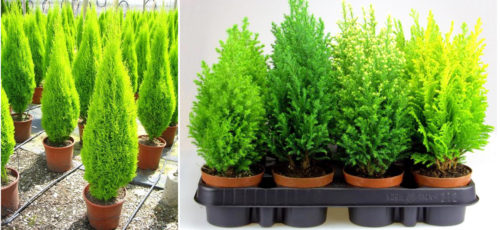

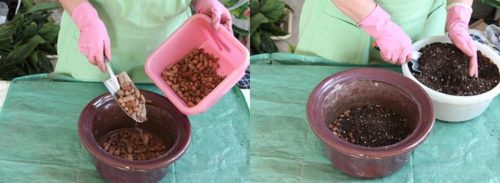

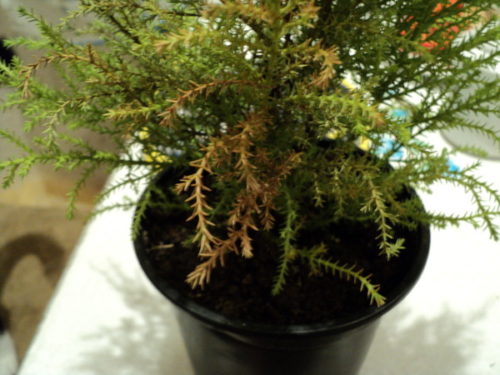








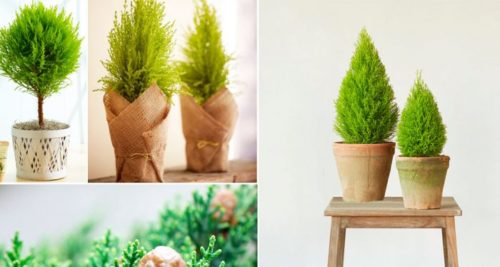


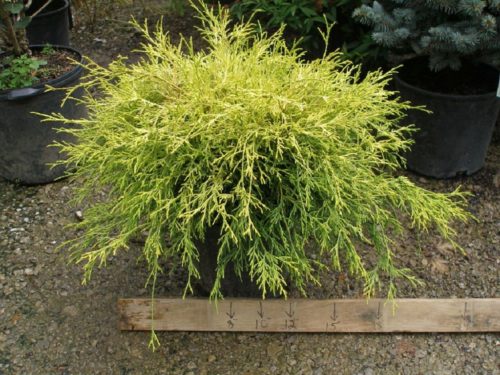
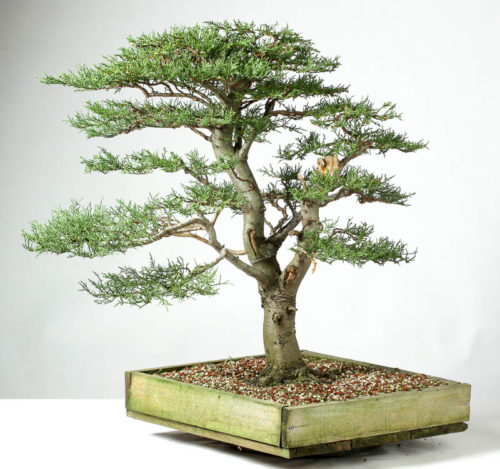

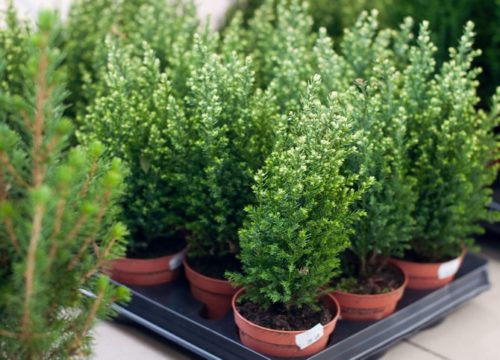
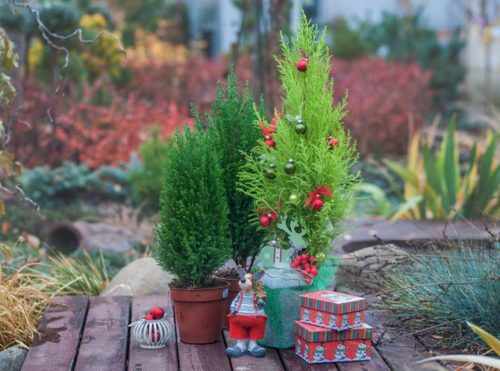












 Start a discussion ...
Start a discussion ...